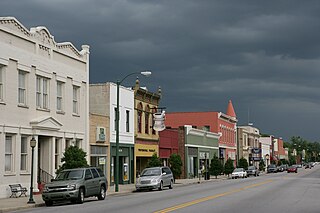
Marion is a city in and the county seat of Marion County, South Carolina, United States. It is named for Francis Marion, a brigadier general from South Carolina in the American Revolutionary War. The population was 6,939 at the 2010 census.
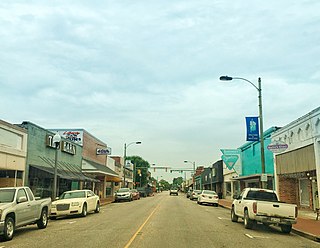
Mullins is a city in Marion County, South Carolina, United States. As of the 2010 census, the city population was 4,663.

Imperial Brands plc, is a British multinational tobacco company headquartered in Bristol, England. It is the world's fourth-largest international cigarette company measured by market share after Philip Morris International, British American Tobacco, and Japan Tobacco, and the world's largest producer of fine-cut tobacco and tobacco papers.

James Buchanan Duke was an American tobacco and electric power industrialist best known for the introduction of modern cigarette manufacture and marketing, and his involvement with Duke University. He was also the founder of the American Tobacco Company in 1890.

Neal and Dixon's Warehouse in Mullins, Marion County, South Carolina, was built circa 1926 for J.S. Neal, C.O. Dixon, and J.H. Dixon, Sr. The virtually unaltered warehouse is a typical example of traditional tobacco warehouse construction. It is also important in the history of tobacco marketing in the area. At the time of its construction Neal and Dixon's Warehouse was said to be one of the largest and most modern warehouses in South Carolina. In the 1926 season, the warehouse employed over 800 people.

This is a list of the National Register of Historic Places listings in Marion County, South Carolina.

Mt. Olive Baptist Church is a historic Baptist church located at 301 Church Street in Mullins, Marion County, South Carolina. It was built between 1922 and 1926, and is a one-story, Late Gothic Revival style brick cruciform building. It has a complex hip and gable roof and features twin corner towers of unequal height, a stained glass oculus above each entrance at the second level, a belfry containing four large pointed arch openings, and a large tripartite Gothic-arched leaded stained glass window flanked by stained glass lancet windows. The church played a major role in the African-American community in Mullins.

The Bright Leaf Historic District is a national historic district located at Durham, Durham County, North Carolina. It encompasses 22 contributing buildings and seven contributing structures in an industrial section of Durham. The majority of the buildings were built from the 1870s to the World War II period, and are massive two- to four-story structures, usually rectangular in form with flat or very shallow gable roofs and of fireproof construction with brick exteriors. Notable buildings include the B. L. Duke Warehouse, the Italianate style W. Duke Sons and Company Cigarette Factory (1884), Liggett and Myers Office Building, Chesterfield Building, Flowers Building (1916), Imperial Tobacco Company Factory (1916), White Warehouse (1926), and five Romanesque Revival style buildings built by The American Tobacco Company trust—Walker Warehouse (1897), Cobb Building (1898), O'Brien Building (1899), Hicks Warehouse (1903) and Toms Warehouse (1903).

The A. H. Buchan Company Building, also known as Supreme Lighting, is a historic tobacco processing facility located at Mullins, Marion County, South Carolina. It was built between 1924 and 1930, and is a two-story, brick building. It features a stepped parapet on the façade. The building was used for the purpose of buying, drying and exporting tobacco. The A. H. Buchan Company operated in this building until 1964.
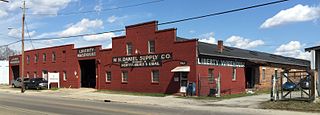
Liberty Warehouse is a historic tobacco warehouse located at Mullins, Marion County, South Carolina. It was built about 1923, and is a 1 1/2-story, brick warehouse. It features stepped parapets and has a metal double gable roof. The warehouse is associated with the Daniel family, the most prominent family associated with tobacco in Mullins.
Old Brick Warehouse was an historic tobacco warehouse located at Mullins, Marion County, South Carolina. It was built between 1903 and 1908, and is a 1 1/2 story, brick building with stepped parapets. The original portion of the building has a slightly gabled roof. A 1960s addition had a flat built-up roof. All elevations contain loading and drive-in bays. It is believed to be the first brick tobacco warehouse in Mullins.
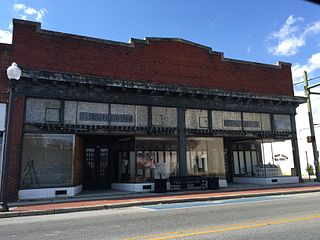
Rasor and Clardy Company Building is a historic commercial building located at Mullins, Marion County, South Carolina. It was originally a jail prior to 1914 when it was converted into a mercantile called the Rasor and Clardy Company, and is a two-story, brick commercial building. The building features metalwork, stained glass and glass tile, mosaic tiles at the entranceways, wooden coffered ceilings in the display windows, and pressed metal interior cornices and ceilings. It is considered the most intact early-20th century commercial building remaining in Mullins.
Dew Barn is a historic tobacco barn for curing leaves located near Zion, Marion County, South Carolina. It was built before 1935, and is a hewn-timber tobacco barn with a steep, metal-covered gable roof, surrounded on all sides by a metal-roofed shed. The barn has an arched brick firebox, which supplied the heat for curing.
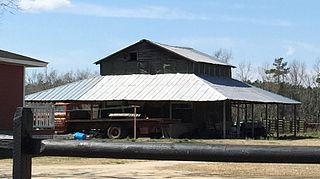
Dillard Barn is a historic tobacco barn for curing leaves close to Mullins, Marion County, South Carolina. It was built in about 1894–95, and is a single-pen plan, log barn supported by a brick foundation with a dirt floor. It was used for curing tobacco from its construction until 1981.

J.C. Teasley House was a historic home located at Mullins, Marion County, South Carolina. The house consisted of the original block built about 1875, with a post-1901 wing, which became the principal façade of the house. It was a modest single-story frame house constructed in a classic folk form quite common throughout the rural South. It was the home of James Chesley Teasley (1861-1942), a prominent Marion County businessman. It is located in the Mullins Commercial Historic District.

Marion High School is a historic school building located at Marion, Marion County, South Carolina. It was built in 1923–1924, and is a one-story, Classical Revival style brick building. The building's main façade features baroque massing with projecting central and end pavilions. When built, the school included a gymnasium, a physics and chemistry laboratory, a domestic science department with sewing and cooking rooms, agriculture laboratory, and a commercial department. The building served as a high school until 1975, then became the home for Marion Elementary School until 1994. The building now serves as the headquarters for the Marion County School District.

Mullins Commercial Historic District is a national historic district located at Mullins, Marion County, South Carolina. The district encompasses 38 contributing buildings in the central business district of Mullins. It includes an intact collection of late 19th and early 20th century commercial and other public buildings. The buildings illustrate the growth and development of Mullins from its beginnings as a railroad town to its prominence as the leading tobacco market in South Carolina for most of the 20th century. The buildings were constructed between 1895 and about 1945, and represent stylistic influences ranging from late Victorian period examples displaying elaborate brick-corbeled cornices and pediments to the more simplified and minimalist Depression-era examples with typical low relief detailing and vertical piers. Notable buildings include the Old Martin Hospital (1937), Vaughan Hotel (1921), Mullins Library (1941), Old Mullins Post Office, Bank of Mullins / Anderson Brothers Bank, and Mullins Depot (1901). Located in the district are the separately listed Old Brick Warehouse and J.C. Teasley House.

The American Tobacco Historic District is a historic tobacco factory complex and national historic district located in Durham, Durham County, North Carolina. The district encompasses 14 contributing buildings and three contributing structures built by the American Tobacco Company and its predecessors and successors from 1874 to the 1950s. Located in the district is the separately listed Italianate style W. T. Blackwell and Company building. Other notable contributing resources are the Romanesque Revival style Hill Warehouse (1900), Washington Warehouse (1902–07), the Lucky Strike Building (1901–02), and Reed Warehouse; Noell Building ; Power Plant and Engine House (1929–39); and the Art Moderne style Fowler (1939) Strickland (1946) and Crowe (1953) buildings.

Rocky Mount Central City Historic District is a national historic district located at Rocky Mount, Edgecombe County and Nash County, North Carolina. The district encompasses 166 contributing buildings in central Rocky Mount. It includes a variety of industrial, commercial, residential, and institutional buildings dating from the late-19th through mid-20th centuries. Notable buildings include the Firestation No. 2 (1924), Union Bus Station (1951), the Railway Express Agency Building, Memorial Hospital (1937), Church of the Good Shepherd (1877), Atlantic Coastline Railroad Station (1903-1916), Imperial Tobacco Company Processing Plant (1903-1923), S. H. Kress and Company, Belk-Tyler, Grand Theater, Manhattan Theater, Holy Hope Episcopal Church (1910s), and Summerlin House (1895).

W. F. Smith and Sons Leaf House and Brown Brothers Company Building, also known as Piedmont Leaf Tobacco Co., is a historic tobacco manufacturing complex located at Winston-Salem, Forsyth County, North Carolina. The complex includes two buildings. The W. F. Smith and Sons Leaf House was built about 1890, and is a 4 1/2-story, nine bays long and three bays wide, stuccoed brick building with a stepped gable facade. The former Brown Brothers building, was built between 1890 and 1895, and is a five-story brick building with a mansard roof and hip roof dormer windows. By 1900 both buildings housed tobacco prizeries.






















